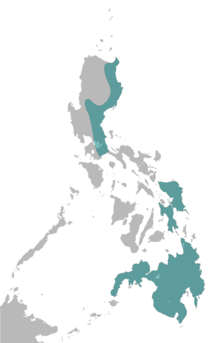Philippine eagle
| Philippine eagle | |
|---|---|
 |
|
| Scientific classification | |
| Kingdom: | Animalia |
| Phylum: | Chordata |
| Class: | Aves |
| Order: | Accipitriformes |
| Family: | Accipitridae |
| Genus: |
Pithecophaga Ogilvie-Grant, 1896 |
| Species: | P. jefferyi |
| Binomial name | |
|
Pithecophaga jefferyi Ogilvie-Grant, 1897 |
|
 |
|
| Range in blue | |
The Philippine eagle (Pithecophaga jefferyi), also known as the monkey-eating eagle or great Philippine eagle, is an eagle of the family Accipitridae endemic to forests in the Philippines. It has brown and white-coloured plumage, and a shaggy crest, and generally measures 86 to 102 cm (2.82 to 3.35 ft) in length and weighs 4.7 to 8.0 kilograms (10.4 to 17.6 lb). It is considered the largest of the extant eagles in the world in terms of length and wing surface, with the Steller's sea eagle and the harpy eagle being larger in terms of weight and bulk. Among the rarest and most powerful birds in the world, it has been declared the Philippine national bird. It is critically endangered, mainly due to massive loss of habitat due to deforestation in most of its range. Killing a Philippine eagle is punishable under Philippine law by 12 years in prison and heavy fines.
The first European to study the species was the English explorer and naturalist John Whitehead in 1896, who observed the bird and whose servant, Juan, collected the first specimen a few weeks later. The skin of the bird was sent to William Robert Ogilvie-Grant in London in 1896, who initially showed it off in a local restaurant and described the species a few weeks later.
Upon its scientific discovery, the Philippine eagle was first called the monkey-eating eagle because of reports from natives of Bonga, Samar, where the species was first discovered, that it preyed exclusively on monkeys; from these reports it gained its generic name, from the Greek pithecus (πίθηκος) ("ape or monkey") and phagus (-φάγος) ("eater of"). The species name commemorates Jeffery Whitehead, the father of John Whitehead. Later studies revealed, however, that the alleged monkey-eating eagle also ate other animals, such as colugos, civets, large snakes, monitor lizards, and even large birds, such as hornbills. This, coupled with the fact that the same name applied to the African crowned eagle and the Central and South American harpy eagle, resulted in a presidential proclamation to change its name to Philippine eagle in 1978, and in 1995 was declared a national emblem. This species has no recognized subspecies.
...
Wikipedia

